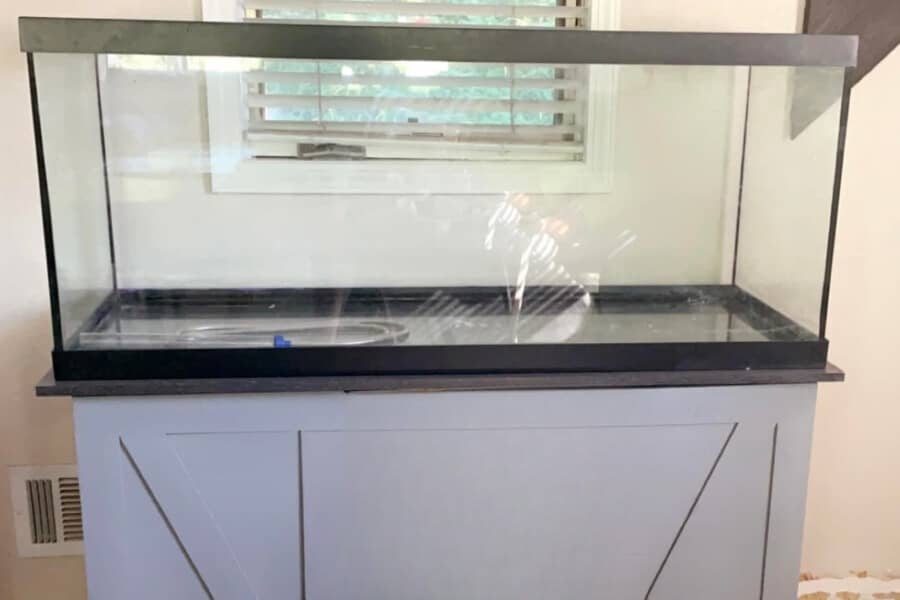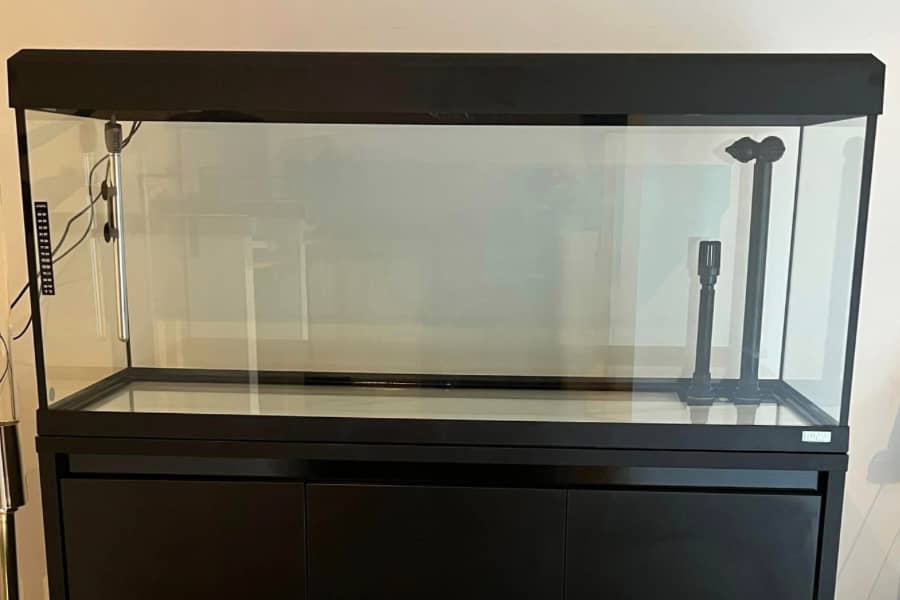Which Glass Is Best For Aquarium?
This post may contain affiliate links.
If you have decided to build an aquarium and are wondering what’s the best quality glass to use, this article is for you. With different types of aquarium glass available, it can be overwhelming to decide which one to use.
In the following sections, we have compared the popular glass options for building fish tanks and have shed light on their pros and cons to make it easy to pick one that best suits your requirements.
What’s The Best Quality Aquarium Glass?

When it comes to building glass aquariums, tempered and float glass are the most commonly used materials.
Tempered (or toughened) glass is comparatively stronger, but you have to be careful of the corners. If it ever gets hit at the edges, the aquarium will blow up, shattering into hundreds or thousands of tiny pieces.
On the other hand, when a float glass breaks, the panel may get a leaking crack (minor ones are easily repairable) or a few large shards if the tank gets hit harder.
In short, tempered glass explodes and float glass cracks. The failure of the former will result in the entire volume of water dumping all at once. Whereas the latter’s failure will cause a slow dripping leak that could possibly be fixed.
Therefore, most hobbyists tend to avoid tempered glass and prefer float glass.
Almost all fish tanks are built of regular float glass and some with low iron glass.
If you are wondering what’s the difference between the two, the following is a detailed comparison:
Low Iron Glass Vs. Regular Float Glass
When choosing glass for custom-built aquariums, there are certain factors one must look for.
NOTE: Low iron glass is also known as ultra clear glass, and standard float glass is commonly called annealed glass. We will use the terms interchangeably, so don’t get confused.
Clarity:
As the name implies, low-iron glass contains less iron content than standard glass.
Due to this reduced quantity, low-iron glass is exceptionally clear, allowing the colors of your fish and coral to pop in a way that you simply can’t see looking through regular glass.
On the other hand, standard float glass has a greenish tint to it because of the substantially higher iron oxide. It is more visible when the lights are off or when viewed from the end of the panel. This can sometimes hinder a perfect view of your aquarium.
With a high visible light transmittance of 91% at 6mm, you can see the true colors of objects through low iron glass without any distortion. For regular glass, the VLT is 89% at 6mm.
In a nutshell, aquariums made of low iron glass are far clearer and more transparent than standard float glass.
Strength and Scratch-ability
The consensus is that there is no difference in the mechanical properties of low iron and annealed glass.
But the truth is, not all ‘glass’ is made the same. A glass’s tensile strength and hardness can differ based on the manufacturer and the formulation technique used.
Typically, regular float glass is harder by a fair margin than low iron glass.
Coming to scratchability, due to the higher optical clarity, the scratches on the low iron glass are more easily noticeable than in annealed glass.
Regular glass is believed to be scratch-resistant, but it’s not entirely true. It also gets scratched, but the marks are hardly visible unless deeply carved in the glass.
Budget:
Due to the production difficulty, low iron glass is costlier than regular float glass. But, if you want the ultra-clear view of your colorful underwater habitat, the expense is worth it.
Maintenance:
Aquariums made from low iron glass can be challenging to maintain as dirt or smudges are easily spotted due to the low level of tinting.
Secondly, you must delicately handle and be extra careful during routine cleaning to avoid scratches. Even the tiniest marks can be visibly apparent on low iron glass, which can ruin your tank’s appearance.
When it comes to your standard float glass, it doesn’t require as much care. However, it’s quite heavier, so you might have difficulty moving it from one place to another, especially if you have a bigger aquarium.
The Verdict: Which Is Better?
It’s subjective – a matter of personal choice. Instead of asking which is better, you should ask which glass is most suitable for you. The point is, as an individual, what do you prefer in a tank?
For instance, if you want glass clarity and an exceptional viewing experience, choose low-iron glass. But, if you don’t want to invest a lot of money building a fish tank and are looking for a budget option, go for standard float glass.
A common practice among custom aquarium builders is to utilize both low iron and annealed glass. Most hobbyists would use ultra-clear glass for the three main viewing panels (front and sides) and regular glass for the bottom and back.
Alternatively, if you want to save money, keep the front pane as low iron and the rest of them as regular glass.
Do you know most aquarists prefer tempered glass at the bottom due to its strength?
StarFire: The Best Ultra Clear Glass For Aquariums
There are different grades of low-iron glass available in the market. The glass clarity significantly varies depending on the manufacturer.
StarFire is a brand name for a high-grade low-iron glass manufactured by Vitro. It is believed to have better clarity than other brands.
However, the problem is that the term ‘Starfire’ is generically thrown around for the entire gamut of low-iron or ultra-clear glass, which can easily lead to confusion and hobbyists fooling into buying low-grade glass.
Therefore, it’s crucial to ask the manufacturer about the brand to ensure it’s truly Starfire and not some other type of low-iron glass.
While Starfire may be the most recognizable brand name for low-iron glass, there are others on the market as well, including Guardian Industries UltraClear or Ultrawhite glass, Pilkington’s Optiwhite, Starlite, Krystal Klear, Diamant, and Eurowhite.
Is Tempered Glass Any Good?

Tanks made of tempered glass are comparatively cheaper and lighter. They are stronger on the face and can withstand a good amount of whack, but if get tapped on the edges (under water pressure), the tank will explode.
Now, some people might say that it’s unlikely their tank will ever get hit on the sides. If you think the same way, feel free to use tempered glass.
As a safety measure, you can have an aluminum profile to protect corners from any impacts that may potentially damage the aquarium.
Some Related Questions
How to prevent scratches on glass aquariums?
It is mainly during the cleaning when scratches occur. Usually, the culprit is getting a piece of the substrate between the glass and your cleaner. For aquariums made of low-iron glass, even a grain of sand is enough to cause ‘eyesore scratches.’ You can use a magnetic algae scraper to clean your tank, but make sure not to bring it too close to the sand bed. And always inspect the scraper faces before using it on the tank.
What type of glass is best for the aquariums?
The one-size-fits-all approach doesn’t work in this case. Your individual preference will dictate the type of glass you should get. For instance, if visual clarity is your utmost priority, look no further than low-iron/ultra-clear glass. In a similar fashion, if you are aiming to build a cost-effective aquarium, it’s best to get standard float glass or just 1 low iron glass panel for the front.
Conclusion
DIYing a fish tank can indeed save you a good amount of money. We hope that, with the help of this guide, you are able to determine which glass best fits your requirements.
